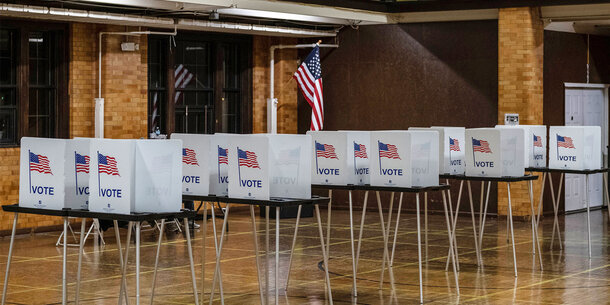More than seven months after Arizona officials certified the 2020 presidential election results, the state senate’s ongoing partisan review of Maricopa County’s results has received national attention. But what’s happening in Arizona is not an isolated incident. Just last week, the Associated Press reported that Senate Republicans in Pennsylvania are considering a similar review there. In fact, there are similar efforts by partisan, political actors to conduct these reviews in jurisdictions around the country. In this report we look at five states — Arizona, Wisconsin, Pennsylvania, Michigan, and Georgia — where these efforts have made significant progress.
In each state, the partisan review efforts have taken different forms and are in different stages. For instance, in Arizona, the State Senate’s review has been limited to a single county (Maricopa). In the course of that review, paper ballots and voting machines were removed from the custody and control of local election officials and given to a third party, which conducted an “examination” of those election materials, sometimes outside public view. By contrast, in Wisconsin, the State Assembly has announced an investigation of the 2020 election without stating that its review would be limited to any particular geographic location. Nor is it at all clear that the Wisconsin review will involve examination of paper ballots or machines, as in Arizona.
While details differ, in every case, the proposed election reviews fail to satisfy basic security, accuracy, and reliability measures that should be in place for any election review. And the “auditors” themselves fail to meet basic standards of objectivity. Specifically, in each state, the actual or proposed partisan reviews fail to meet at least some of the following components:
- Transparency: public audit plans, processes, and records;
- Objectivity: auditors who are and appear to be independent and free of conflicts of interest;
- Pre-written, comprehensive procedures: standardized and consistently implemented processes designed to achieve accuracy;
- Competence: conducted by election administration experts; and
- Security: ballots and equipment remain in election official control.
These deficiencies stand in stark contrast to actions that experienced election administrators take to verify the security of an election, as well as minimum standards external auditors apply when conducting governmental performance audits.
Standard Election Integrity Measures
Election officials across the country incorporate numerous election security and integrity measures into every step of the election cycle, including voter registration record management, election administration, and results certification. These procedures include routine voter registration list maintenance activities, such as removing voters based on official death records. footnote1_08i292r 1 U.S. Election Assistance Commission, “News Fact Sheet: Voter Registration List Maintenance,” accessed June 28, 2021, https://www.eac.gov/news/2017/03/10/fact-sheet-voter-registration-list-maintenance. For a sample of state voter registration list maintenance reports published by election officials in Pennsylvania and Wisconsin, see U.S. Election Assistance Commission, “State List Maintenance Procedures,” accessed July 5, 2021, https://www.eac.gov/state-list-maintenance-procedures. Most are implemented well before elections occur, and include logic and accuracy testing of voting machines, chain of custody procedures, and checklists to ensure that other routine tasks — such as notifying voters about an upcoming election or adding voters to permanent voter lists — are conducted in compliance with relevant federal and state laws.
After the election occurs, the full process for counting votes involves a series of steps that take place over several weeks. Each of these steps has safeguards in place to protect voters’ rights and the integrity of our elections. They are conducted in public; citizens and the media can (and should) ensure that they are done properly. These steps and safeguards, which vary by state, may include proprietary style codes and post-election canvass verification procedures. They are explained in the Brennan Center analysis “The Roadmap to the Official Count in an Unprecedented Election,” and by multiple U.S. Department of Homeland Security’s Cybersecurity and Infrastructure Security Agency publications, including “Mail-In Voting: Election Integrity Safeguards” and “Mail-In Voting Processing Factors.” footnote2_49648b6 2 Derek Tisler, Elizabeth Howard, and Edgardo Cortés, “The Roadmap to the Official Count in an Unprecedented Election,” Brennan Center for Justice, October 26, 2020, https://www.brennancenter.org/our-work/research-reports/roadmap-official-count-unprecedented-election; U.S. Cybersecurity and Infrastructure Security Agency, ”Mail-In Voting: Election Integrity Safeguards,” July 31, 2020, https://www.cisa.gov/sites/default/files/publications/mail-in-voting-election-integrity-safeguards_508.pdf; and U.S. Cybersecurity and Infrastructure Security Agency, “Mail-In Voting Processing Factors,” accessed June 23, 2021, https://www.cisa.gov/sites/default/files/publications/mail-in-voting-processing-factors_oct-29_508.pdf.
In the rare instance that any specific and plausible allegations or evidence of malfeasance arise, officials refer these to the appropriate agencies, often a law enforcement agency. footnote3_fseddxg 3 Charles Benson, “Very Few Suspected Cases of Illegal Voting in 2020 Wisconsin Elections: Report,” June 2, 2021, TMJ-4 Milwaukee, https://www.tmj4.com/decision2020/very-few-suspected-cases-of-illegal-voting-in-2020-wisconsin-elections-report; and Georgia Secretary of State, “State Election Board Refers Voter Fraud Cases for Prosecution,” accessed June 23, 2021, https://sos.ga.gov/index.php/elections/state_election_board_refers_voter_fraud_cases_for_prosecution. When an external process audit is warranted, generally accepted governmental auditing standards (GAGAS), also known as The Yellow Book, can be used. footnote4_builgay 4 The GAGAS “are the guidelines for audits created by the Comptroller General and the audit agency of the United States Congress, the Government Accountability Office.” Seattle Office of Inspector General, “About Generally Accepted Government Auditing Standards,” accessed July 5, 2021, https://www.seattle.gov/oig/audits/about-gagas; U.S. Government Accountability Office, “Yellow Book,” accessed July 5, 2021, https://www.gao.gov/yellowbook; Comptroller General of the United States, Government Auditing Standards, 2003 Revision, U.S. Government Accountability Office, June 2003, https://www.gao.gov/assets/gao-03–673g.pdf. U.S. Government Accountability Office, Government Auditing Standards, 2018 Revision, accessed July 5, 2021, https://www.gao.gov/assets/gao-18–568g.pdf. These minimum standards are echoed in the Information Systems Auditing Association’s IS Auditing Standards which require members serving as auditors to “[p]erform their duties with objectivity, due diligence, and professional care, in accordance with professional standards and best practices.” Certified Information Systems Auditor Exam Cram 2, “ISACA IS Auditing Standards and Guidelines and Code of Professional Ethics,” Macmillan Computer Pub, April 13, 2005, https://flylib.com/books/en/2.383.1.28/1/. The standards identify an auditor’s objectivity, defined to include “independence of mind and appearance when conducting engagements, maintaining an attitude of impartiality, having intellectual honesty, and being free of conflicts of interest,” as “the basis for the credibility of auditing in the government sector.” footnote5_0xdlu09 5 Comptroller General of the United States. Government Auditing Standards, 2018 Revision, (emphasis added).
These standard election security and integrity procedures culminate in a post-election tabulation audit. Election officials in each state discussed in this report conducted post-election tabulation audits that required them to check a sample of cast ballots to ensure the voting machine results’ accuracy. These audits were conducted in 2020, shortly after the election, as required by state statute and in compliance with written procedures drafted before the audit launch. footnote6_y09ck1u 6 Michigan Comp. Laws § 168.31a(2); 25 Penn. Stat. § 3031.17; Wis. Stat. § 7.08(6); Wisconsin Elections Commission, “2020 Post-Election Voting Equipment Audit Procedures,” https://elections.wi.gov/sites/elections.wi.gov/files/2020–11/2020%20Audit%20Instructions%20and%20Procedures.pdf; Ga. Code § 21–2–498; VotingWorks, “Instructions for Risk Limiting Audit Full Manual Tally,” accessed July 5, 2021, https://docs.google.com/document/d/1AVnIRqnkK2YidM-lszHfuq6DGZ0S5VSOlZMipmASt9A/edit; Ariz. Rev. Stat. (“A.R.S.”) § 16–602. While the specific procedures, such as the counting method, vary by state, all procedures were written and implemented in a manner designed to increase trust in our election system, by providing for transparency into the process, giving responsibility for conducting the audit to those with election administration experience, and using procedures designed to obtain an accurate count. They were also conducted in compliance with federal law requiring election officials to protect and preserve election materials and retain “ultimate management authority over the retention of those election records.” footnote7_0a888bu 7 U.S. Department of Justice, Federal Prosecution of Election Offenses, Eighth Edition, edited by Richard C. Pilger, Election Crimes Branch, Public Integrity Section, December 2017, 79, https://www.justice.gov/criminal/file/1029066/download.
Moreover, in each state we examine, well-established law offers or ensures candidates in close elections access to a recount. However, in 2020 in each state, the Trump campaign either failed to qualify for a recount (because the margin wasn’t sufficiently close), failed to request a recount, or requested a recount that ultimately provided additional confirmation of the outcome’s accuracy.
Despite these facts, Trump supporters continue to make false claims of fraud in support of these endeavors to transfer federal election materials to inexperienced, political actors for review. As explained in more detail in this report, the procedures proposed for these reviews are not designed to obtain secure and accurate results and are radically different from proven election integrity procedures, such as post-election tabulation audits, routinely conducted by election officials across the country. That these efforts are gaining traction more than six months after certification of the election is a blinking red warning light.
With research and writing support from Turquoise Baker.
End Notes
-
footnote1_08i292r
1
U.S. Election Assistance Commission, “News Fact Sheet: Voter Registration List Maintenance,” accessed June 28, 2021, https://www.eac.gov/news/2017/03/10/fact-sheet-voter-registration-list-maintenance. For a sample of state voter registration list maintenance reports published by election officials in Pennsylvania and Wisconsin, see U.S. Election Assistance Commission, “State List Maintenance Procedures,” accessed July 5, 2021, https://www.eac.gov/state-list-maintenance-procedures. -
footnote2_49648b6
2
Derek Tisler, Elizabeth Howard, and Edgardo Cortés, “The Roadmap to the Official Count in an Unprecedented Election,” Brennan Center for Justice, October 26, 2020, https://www.brennancenter.org/our-work/research-reports/roadmap-official-count-unprecedented-election; U.S. Cybersecurity and Infrastructure Security Agency, ”Mail-In Voting: Election Integrity Safeguards,” July 31, 2020, https://www.cisa.gov/sites/default/files/publications/mail-in-voting-election-integrity-safeguards_508.pdf; and U.S. Cybersecurity and Infrastructure Security Agency, “Mail-In Voting Processing Factors,” accessed June 23, 2021, https://www.cisa.gov/sites/default/files/publications/mail-in-voting-processing-factors_oct-29_508.pdf. -
footnote3_fseddxg
3
Charles Benson, “Very Few Suspected Cases of Illegal Voting in 2020 Wisconsin Elections: Report,” June 2, 2021, TMJ-4 Milwaukee, https://www.tmj4.com/decision2020/very-few-suspected-cases-of-illegal-voting-in-2020-wisconsin-elections-report; and Georgia Secretary of State, “State Election Board Refers Voter Fraud Cases for Prosecution,” accessed June 23, 2021, https://sos.ga.gov/index.php/elections/state_election_board_refers_voter_fraud_cases_for_prosecution. -
footnote4_builgay
4
The GAGAS “are the guidelines for audits created by the Comptroller General and the audit agency of the United States Congress, the Government Accountability Office.” Seattle Office of Inspector General, “About Generally Accepted Government Auditing Standards,” accessed July 5, 2021, https://www.seattle.gov/oig/audits/about-gagas; U.S. Government Accountability Office, “Yellow Book,” accessed July 5, 2021, https://www.gao.gov/yellowbook; Comptroller General of the United States, Government Auditing Standards, 2003 Revision, U.S. Government Accountability Office, June 2003, https://www.gao.gov/assets/gao-03–673g.pdf. U.S. Government Accountability Office, Government Auditing Standards, 2018 Revision, accessed July 5, 2021, https://www.gao.gov/assets/gao-18–568g.pdf. These minimum standards are echoed in the Information Systems Auditing Association’s IS Auditing Standards which require members serving as auditors to “[p]erform their duties with objectivity, due diligence, and professional care, in accordance with professional standards and best practices.” Certified Information Systems Auditor Exam Cram 2, “ISACA IS Auditing Standards and Guidelines and Code of Professional Ethics,” Macmillan Computer Pub, April 13, 2005, https://flylib.com/books/en/2.383.1.28/1/. -
footnote5_0xdlu09
5
Comptroller General of the United States. Government Auditing Standards, 2018 Revision, (emphasis added). -
footnote6_y09ck1u
6
Michigan Comp. Laws § 168.31a(2); 25 Penn. Stat. § 3031.17; Wis. Stat. § 7.08(6); Wisconsin Elections Commission, “2020 Post-Election Voting Equipment Audit Procedures,” https://elections.wi.gov/sites/elections.wi.gov/files/2020–11/2020%20Audit%20Instructions%20and%20Procedures.pdf; Ga. Code § 21–2–498; VotingWorks, “Instructions for Risk Limiting Audit Full Manual Tally,” accessed July 5, 2021, https://docs.google.com/document/d/1AVnIRqnkK2YidM-lszHfuq6DGZ0S5VSOlZMipmASt9A/edit; Ariz. Rev. Stat. (“A.R.S.”) § 16–602. -
footnote7_0a888bu
7
U.S. Department of Justice, Federal Prosecution of Election Offenses, Eighth Edition, edited by Richard C. Pilger, Election Crimes Branch, Public Integrity Section, December 2017, 79, https://www.justice.gov/criminal/file/1029066/download.







